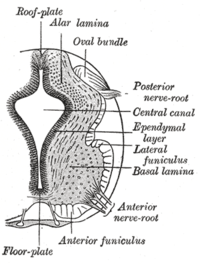Floor plate
| Floor plate | |
|---|---|

The floor plate separates the left and right basal plates of the developing neural tube.
|
|
| Details | |
| Precursor | |
| System | Nervous system |
| Dorlands /Elsevier |
l_02/12475910 |
|
Anatomical terminology
[]
|
|
The floor plate is a structure integral to the developing nervous system of vertebrate organisms. Located on the ventral midline of the embryonic neural tube, the floor plate is a specialized glial structure that spans the anteroposterior axis from the midbrain to the tail regions. It has been shown that the floor plate is conserved among vertebrates with homologous structures in invertebrates such as the fruit fly Drosophila and the nematode C. elegans. Functionally, the structure serves as an organizer to ventralize tissues in the embryo as well as to guide neuronal positioning and differentiation along the dorsoventral axis of the neural tube.
Induction of the floor plate during embryogenesis of vertebrate embryos has been studied extensively in chick and zebrafish and occurs as a result of a complex signaling network among tissues, the details of which have yet to be fully refined. Currently there are several competing lines of thought. First, floor plate differentiation may be mediated by inductive signaling from the underlying , an axial mesoderm derived signaling structure. This is supported experimentally in chick, in which floor plate induction, as well as associative ventral nervous tissue differentiation, is mediated by the secreted signaling molecule Sonic hedgehog (Shh). Shh is expressed in a gradient with highest concentration localized in the notochord and floor plate. In vitro tissue grafting experiments show that removal of this molecule prevents differentiation of the floor plate, whereas its ectopic expression induces differentiation of floor plate cells. An alternative view proposes that neural tube floor plate cells stem from precursor cells which migrate directly from axial mesoderm. Through chick – quail hybrid experiments as well as genetic interaction experiments in zebrafish, it appears that notochord and floor plate cells originate from a common precursor. Furthermore, in zebrafish, Nodal signaling is required for differentiation of medial floor plate cells whereas Shh is expendable. These data may indicate that the floor plate induction mechanism in amniotes and anamniotes differs. To reconcile these differences, a dual-mode induction model has been proposed in chick. In this model, exclusively ectodermal cells are induced to become medial floor plate during gastrulation by prechordal mesoderm, possibly through Nodal signaling. Later in development during neurulation, extended contact and interaction between notochord and fated floor plate cells causes differentiation, suggesting a cooperative effect between Nodal and Shh signaling.
...
Wikipedia
